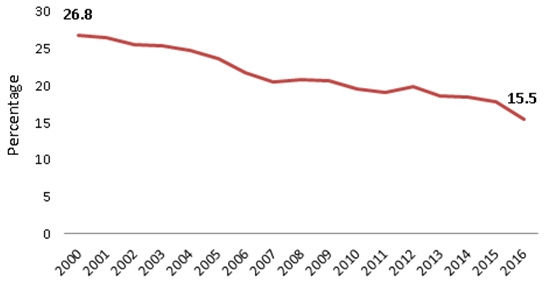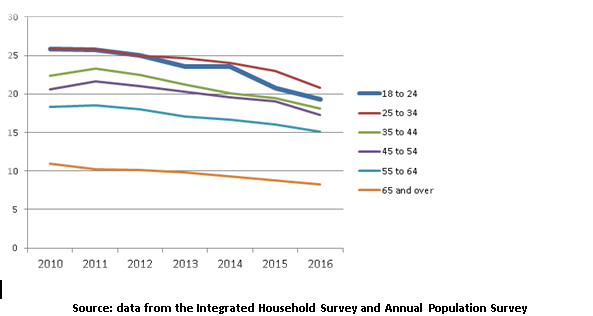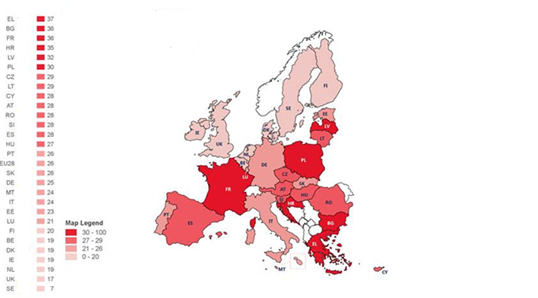
New data on smoking prevalence among adults (18+) in England for 2016 show the biggest drop in a decade with the rate falling to 15.5% of the population, a 1.4 percentage point drop from 16.9% the previous year.
But what is even more encouraging, indeed fantastic news, is that this steep decline is even greater among younger adults, aged 18-29 years.
The data from the Adult Smoking Habits in the UK: 2016 report was jointly published by Public Health England and the Office for National Statistics.
NHS Digital incorporated our prevalence data into their Statistics on Smoking, England 2017 report, published on the same day.
This fall means that within just one year there were over half million fewer smokers. The last time we saw such a sizeable drop in smoking was back in 2006 (a 1.9 percentage point reduction), but this was from a higher base of 21.8%.
Adult smoking rates in Britain

Figures among younger adults are hugely encouraging
For the first time, the figures show that the biggest drop is among younger adults, aged 18-29 years, with smoking rates having fallen by a staggering quarter since 2010.
This reverses a long trend, which has seen rates among this younger group stubbornly fall at a lower rate than the overall population.
Smoking rate reductions between 2015 and 2016 among younger adults:
- 18-24 year olds: from 20.8% to 19.5% (1.3 percentage point drop)
- 25-29 year olds: from 24.1% to 21.6% (2.5 percentage point drop)
- 30-34 year olds: from 21.6% to 19.6% (2.0 percentage point drop)
Smoking prevalence by age group since 2010

The second lowest smoking rates in Europe
Even before the publication of these new figures, an EU survey last month, the Eurobarometer, shows that the UK has the second lowest smoking rates in Europe after Sweden.
It is a great achievement that we are at the forefront in Europe in tackling smoking but it also shows that, compared to Sweden, we still have some way to go. Sweden’s success may be largely due to the widespread use of Snus, a chewable smokeless tobacco product.
Eurobarometer Survey 2017: % population smoking rates in Europe

The impact of e-cigarettes on smoking rates
Although e-cigarette use increased more among young adults, smoking rates fell fastest in this age group. England is leading the world in maximising the benefits from e-cigarettes, while minimising the risks, and yesterday’s new figures certainly are encouraging.
Combined efforts
Our success can justifiably be attributed to all those working in tobacco control and their combined efforts.
Undoubtedly, the ending of smoking in enclosed public places in 2007 was the single most important public health reform in generations (we will soon be celebrating the ten year anniversary on 1st July) and public support for the ban has grown, now at 83%.
The 2013 NICE guidance on smoking in acute, maternity and mental health services recommended that smoking should be banned on the grounds of hospitals and this has been widely, though not yet fully, implemented.
Last December, I spearheaded a PHE campaign to support and encourage hospitals to become fully smokefree, not just prohibiting smoking but maximising the opportunities to engage with patients, as well as staff, to quit.
A range of other legislative measures have been introduced since 2007, including increasing the legal age of sale from 16 to 18, a ban on vending machines, prohibiting tobacco display in shops and a range of measures on health warnings.
And, of course, the icing on the cake last year - the victory over standard packaging, which has now become a reality.
Smoking is one of PHE’s key priorities and we have worked tirelessly in supporting both government and local public health teams with a wide range of evidence, data and tools.
Our mass marketing campaigns, Stoptober and Health Harms, have had great success in engaging the public and smokers. Stoptober has inspired over one million quit attempts across England since it launched in 2012.
And over five million people have viewed our Harms content online, with 75% of smokers aware of our messages and around 10% making a quit attempt as a result.
Although these latest prevalence figures are great news, 6.7 million adults in England still smoke and it remains the biggest killer, with around 79,000 deaths attributable to smoking in 2015.
This represents 16% of all deaths, and for every death caused by smoking, approximately 20 smokers are suffering from a smoking-related disease. Meanwhile the burden on the NHS continues to be massive, with the total annual cost estimated at £2bn, with a further £1.1bn in social care costs.
Gender and regional gaps persist
Gaps and health inequalities still persist between the sexes and the regions, or to be clearer, the richest and the poorest areas.
The gender gap continues to grow. In England 17.4% of men smoke compared to 13.7% of women. And the impact of smoking on health inequalities is even greater.
The smoking rate in affluent Epsom and Ewell is 4.9%, while just 60 miles away on the south coast in Hastings the rate is over five times greater, 25.7%. Smoking remains the biggest cause of health inequalities and accounts for a half of the gap.
Looking forward - the reality of a Smokefree nation
While these gaps persist there is still much work to be done, but these latest figures give us real hope. The fieldwork for this survey ended in December so we haven’t yet seen the effect of standard packaging, but we expect it will reduce rates further particularly among the young.
And if the monthly UCL smoking toolkit study is anything to go by then smoking rates this year have continued to fall rapidly.
Looking forward, if we were to maintain the average rate of reduction we’ve seen over the past five years (0.75%), then by 2030 we would achieve our ambition for a Smokefree nation (which we define as just 5% of the total population smoking).
When you think of the numbers who smoked just over 40 years ago - almost a half of adults (47%) in 1974 - we have come a long way.
We have much to be proud of in our efforts, including all those working in charities, the NHS and Stop Smoking Services; and of course the sheer determination of the millions of individuals who have overcome their addiction and quit for good. Together, we have saved millions of people from years of disability, ill health and premature deaths.
And now an end really is in sight. Working together we have a real opportunity to virtually eliminate all the harm and misery smoking has caused for far too long.
Image: Matt Trostle

4 comments
Comment by Bazz posted on
Take e-cigs out of regulation, make new, sensible ones designed for consumer devices and see further drops in smoking. It isn't rocket surgery. Vaping helps.
Comment by Geoff Vann posted on
First,I should declare an interest – I quit after 35 years of smoking by switching to vaping (and over 7 years later,I still vape).Leaving aside the politics and spin for one moment:
According to ASH & ONS we currently have about 1.5m ex-smoking ecig users and 1.4m dual-users.
According to ONS there are 3.8m smokers (and 0.9m ex-smokers) who have tried/used ecig in the past but no longer.
According to the UCL STS figures,quit attempts using ecigs have plateaued
Despite the reports from PHE in 2015 and RCP in 2016,the public’s perception of the safety of ecigs is declining
The now fully implemented TPD regulations may give the public some comfort as to the safety of ecigs but this is unknown and probably unlikely
These same (and earlier ASA) regulations restrict most advertising and may be a cause of the levelling out of quit attempts
These advertising restrictions are also unlikely to tempt back those who have tried and rejected ecigs,most of whom are likely to have tried only the less effective 1st & early 2nd generation devices
With the EU parliament’s vote having extinguished hopes(for now) of medicinal regulation,the UK’s ecig policy has been to not gold-plate Article 20 of the TPD,to promote the relative safety(but not the relative effectiveness) of ecigs and to encourage our SSS to be ecig-friendly(although current ecig use by the SSS is still no more than 5%)
I would like to see a genuine plan with real proposals from PHE which truly addresses the maximisation of the benefits of ecigs and which may then be incorporated into any future governmental Tobacco Control Plan
Comment by Mark Jarratt posted on
No government claiming to operate according to democratic principles has any moral authority to use the full coercive force of law and obscenely punitive taxes to inflict the elitist vision of a tobacco free utopia on other adults.
The oft repeated comment of anti smokers that the claimed health costs of smoking 'related' illness exceed revenue collected is easily refuted, and relies on an emotive argument based in health eugenics 'you cost us money so we have the right to control your behaviour', with endless scope for petty intrusive micro management of individual lifestyle choices.
Meddling in the informed lifestyle choices of adult citizens is not a legitimate function of government. The public funded decades long crusade against smokers has gone too far and must be wound back, with less fanaticism and more balance.
Comment by Michael J McFadden posted on
This article somehow reminds me of a similar article I read in the US in the 1990s about "The SmokeFree Class Of 2000!" where they anticipated no one born after the early 1980s would ever take up smoking.
Statistics.
- MJM